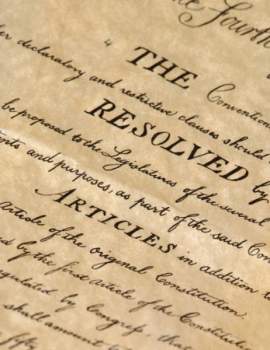
The Declaration of Independence

Popular In Constitution
Purpose Of Lifetime Appointment And Pros And Cons Enumerated Powers Bicameral Legislature Background Article 3 Of The Constitution We The People 1st Amendment Who Wrote The Constitution Judicial Review Equal Protection Clause Three Fifths Compromise 10th Amendment 5th Amendment
The Declaration of Independence is a doctrine that was primarily authored by Thomas Jefferson in 1776, with the assistance of other prominent political figures of the time, such as John Adams, Benjamin Franklin, Robert Livingston, and Roger Sherman. Once the Continental Congress had approved of its contents, they disseminated the final draft of the Declaration of Independence to all of the newly-independent 13 states in the hopes of the document’s ratification. On July 4th, 1776, the Declaration of Independence was approved by 12 of the 13 states of the American Union. New York’s individual State Legislature did not allow its appointed representatives the permission to vote in a national forum. However, New York State approved the document on July 15, 1776, upon being granted permission by its State Legislature. The intended purpose of the Declaration of Independence was multifaceted. As its name suggests, the inception of the Declaration of Independence served to confirm the autonomy of the United States of America as a sovereign nation, emancipated from the control of British monarchy. In no uncertain terms, the Declaration of Independence established a complete disengagement from the British monarchy, as well as King George III. The Declaration of Independence clarified the role of a central government in the United States. Contrasting what was deemed as tyrannical by citizens who had lived under the rule of King George II’s monarchy, the authors of the Declaration of Independence constructed a gubernatorial model which solidified the role of a centralized government as a ruling body whose function is to serve its citizens. The Declaration of Independence illustrates various contingencies in which the citizens of the United States are entitled to overthrow a government that they deem tyrannical. Such contingencies include a central government’s refusal to provide ‘Life, Liberty, and the Pursuit of Happiness’ to its citizens. In addition, the Declaration of Independence calls for the acting central Government to operate under the pretense that the citizens whom it is sworn to protect concede to be governed. This act of concession on the part of the citizens was a contrary dynamic to the previous monarchical model under which the colonists were ruled prior to the Revolutionary War. The authors of the Declaration of Independence wished to illustrate that the citizens of the United States were allowing themselves to be governed, rather than having authority unwillingly foisted upon them. The authors of the Declaration of Independence not only wished to create a new paradigm of governmental rule, but they were also determined to illustrate the flaws of a monarchical ruling body. The remainder of the doctrine assails King George III, who was the acting Monarch of England at the time, of the penning of the Declaration of Independence. Thomas Jefferson, who was considered to be the foremost critic of King George III, outlined the Monarch’s various transgressions against liberty, justice, and democracy. The Declaration of Independence not only solidified the United States as a sovereign nation, but also set the philosophical and political groundwork for the establishment of a governing body that would act as a servant to its citizens - the first political model of its kind.

















